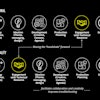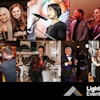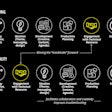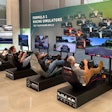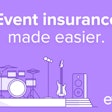
Shel Israel is the author of five books; most recently Age of Context, with co-author Robert Scoble, which focuses on mobile, social media, sensors, location technology, and data and how they impact our work and personal lives. He’s also a frequent speaker and presented, along with Scoble, at Macworld/iWorld this past weekend in San Francisco. In a recent conversation, Israel shared his thoughts on tech trends and their impact on events.
Explain the five trends outlined in Age of Context.
The first is mobile technology, which includes wearable devices. The second is social media. No organization has a go-forward strategy that doesn’t include social media. The third is sensors, [which] is another way of saying the Internet of things. Suddenly there are all sorts of examples of sensors being everywhere. Things are talking to things. Things are talking to people. G.E. has a network with its airplane engines that tells it when maintenance is needed, which not only increases safety, but it saves $3.2 billion in fuel. Fourth is location technologies, which is mapping but goes well beyond that. Our phones and other devices have the ability to know where we are at any given point. [The technology] can help us find things around us, from a cup of coffee if we’re walking to work, to a beer if we’re walking home. That ability to pinpoint where things are and where people are is becoming very important. Finally the fifth is data. It’s become the glue to the other four. What’s really interesting are those little pinpoints of data that you create every time you do a search. We can’t live without this data anymore. Our technology starts knowing us better than whoever the human closest to us is. And it also begins understanding through our patterns what we may want next. The convergence of these five things is where it gets interesting.
What’s an example of how these five forces converge?
The N.F.L. uses context at Gillette Stadium, so it knows where the most loyal fans are seated. It knows that loyal fans have habits, such as they may get a cheesesteak and a beer at halftime. So, for example, four minutes before halftime, the league can use a mobile app to ask that customer if they would like their usual order. If they say yes, they don’t have to pay because their credit card is on file and they just pick it up. The other guys who aren’t part of the loyalty program have to stand in a mile-long line. Where this is going in the future is huge. The guy who gets a cheesesteak might get an offer to say, “How about coming into the clubhouse and having a glass of Pinot and a steak? And we’ll give you a seat by the window, and we’ll give it to you 50 percent off.” And somebody else is using social media and they [tweet], “How come these guys get the short line all the time?” They can get an instant offer saying, “We’re sorry you feel that way. Next time you come, here’s a barcode and you’ll be able to use the short line to make your order.” They can upsell an entire stadium this way.
[PULLQUOTE]
How can this be applied to trade shows and other types of events?
There will be, if not millions, thousands of applications. Every booth can do geofencing, which uses sensors to know if somebody who has talked about the brand on social media is within range. You can send messages to your best customers. You can signal people you are about to deliver a talk and invite them to come into the room. You will be able to understand not only that a person is a customer, but their whole buying record. When they come into your booth, you can say, “Hello, Bill. Did you enjoy the gizmo you bought from us last year? We have an upgrade; would you like to take a look at it?” You can personalize your message to the most important people that come into your booth or area.
One of the issues in marketing in general is all the noise you are not interested in. This contextual technology creates what we call pinpoint marketing: You can know where your customers are, when they are near you, what direction they are walking in, what their intention might be in the moment. You can send messages just to them instead of broadcasting messages or hiring booth bunnies to pass out coupons for free drinks or whatever—most people take those and drop them on the floor and keep walking because it’s just noise.
People are now more concerned about privacy, which you describe as the “freaky line.” Tell us more about that.
The problem is that we don’t necessarily own the data that is being collected on us. We aren’t being made aware of how it is being used. What we have in data is something that [can make] enormous and fundamental changes to the everyday lives of all people connected to the Internet, yet at the same time there are intended and unintended consequences, which can be dangerous. Everybody has a freaky line. It’s the point at which we get uncomfortable with technology. The big trade-off is privacy: the more privacy you give up, the more benefits you can receive.
We think that there are some things that can be done by private business that would push the freaky line way back. One is, Google already allows you to see everything Google has on you, and it will astound you because it’s a lot more than you think it is. Every time you’ve done a search on Google, they collected that data. They know where you went, they know who you are, they know what you like, they know how often you go incognito, but at least they tell you, and that’s a step. What I would like Google to do is go a little further and let me correct mistakes they’ve made, false assumptions they’ve made, which I cannot do. Two is all the stuff that we’re going to wear and take around with us including our phone—we should have the right to turn the damn thing off. If you wear a Nike FuelBand, they want you to keep it on at all times, because sleep is important to your health, but you should have the right to say to your FuelBand or phone, “Shut up. Go to sleep.” Three is you should know where that data is being shared, and why it is being shared and whether it is being shared to serve you or to serve corporate profits. Right now there is none of that.
What are some of the specific devices that are driving these technology trends?
We don’t see any reason why any surviving retailer or conference center would not be just filled with low-energy Bluetooth that talks to phones using iBeacon. It is low-energy. It is faster, better, cheaper. It is better for the environment, and it is a no-brainer to include. We think this is going to be a very rapid adoption because barriers to it are so low. To give you a sense of how fast this is moving, in our book we talk about little tiny sensors that cost less than $10, and we thought that was amazing because two years earlier they cost $100. And now you’ve got low-energy Bluetooth that are a third of the size of my pinky fingernail that cost under $10. It will be talking to a mobile device, which right now is overwhelmingly a phone or an iPad, but in the future it will be reduced to smaller wearable devices including digital glass such as what Google is coming out with, a watch like Apple is coming out with, or digital jewelry and so on. There will be wearable devices similar to Disney’s Magic band. The lines go faster because you hold up your wrist and you go through. It’s collecting data, so they know what you’ve done, they know where you are, and they can make that experience better. I don’t see why that won’t work at any event.
Do you see any risk of technology minimizing the value of face-to-face experiences?
I’ve been a champion of leading-edge technology for 40 years. When I first got into this, Alvin Toffler wrote a best-selling book called Future Shock that warned by this time we’d all be isolated zombies, captivated by large computer screens, never leaving our homes. Yet what has happened so far is that technology has brought people closer together. It has lowered the barriers of the tangible world so we can have friends that share comments all over the world. It’s created the online conference.
All that being said, nothing I’ve ever seen has ever eliminated the value of a face-to-face conversation, has never been able to replicate a handshake or a hug or a smile or the connection between people’s eyes. I think a lot of this stuff makes it easier to find that which is interesting, useful, or attractive to you and makes it easy to filter out the noise from your life. But it certainly doesn’t eliminate the need for face-to-face connection. In the last 15 years, technology has moved people online—out of the Barnes & Noble and into Amazon, out of everything and into Amazon—but now all the stuff we are talking about is bringing people back into the tangible world. The technology has become mobile. It’s become a little thing in our pocket. And now it’s moving into the stadiums, it’s moving into the conference centers, it’s moving into the classroom, it’s moving into the retail stores. I think this is a good thing, and I see no evidence that the issue or danger here is the isolation of people. It’s in our DNA to be social.

